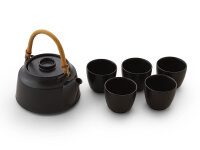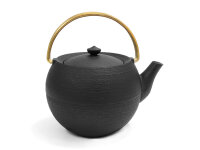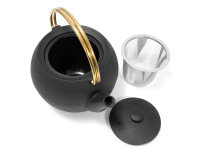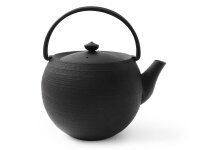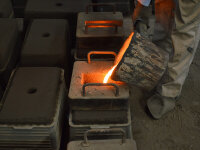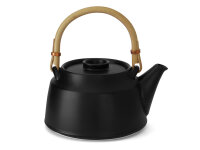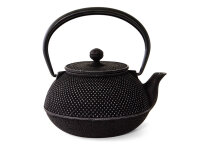
Japanese Teapots, Kyusu
Yokode Kyusu, the Traditional Japanese Teapot for Green Tea
The Kyusu is an exceptional teapot in terms of design and material. While for Matcha, hot water is poured directly into the tea bowl from the cast iron kettle (Tetsubin), for high-quality green teas, the original clay teapot (Kyusu) is traditionally the right choice. Kyusu (Japanese teapot) comes with a side handle, handle, or with a spout. However, most green tea enthusiasts consider the side-handled Kyusu as the best option.
Here is a brief overview of Japanese teapots:
- Uwade Kyusu: Japanese Kyusu with a handle
- Yokode Kyusu: The Kyusu teapot with a side handle
- Ushirode Kyusu: Teapot, typically Asian, with the handle at the back
- Hohin: Japanese teapots without handles: Suitable for Japanese green teas such as Bancha, Sencha, or Gyokuro
- Shiboridashi: This Asian teapot also lacks a handle and is used for Gyokuro
- Dobin: Pot with a top handle. They have a larger capacity and are more similar to Western teapots
Japanese Teapots and Teas
For those who want to optimize their tea experience, both aspects should be considered together. The Asian teapot made of clay – Green tea from Japan – is the most commonly chosen option. Kyusu teapots usually come from Tokoname, a region in Japan known for Asian teapots, rich clay deposits, and traditional kilns. Our Tea Sets from Tokoname include a pot with a strainer and the matching tea bowl as a 2-piece or 5-piece set. This tea set is very popular because it leads to high enjoyment with little effort, especially thanks to the Japanese teapot with a strainer. Of course, high-quality green tea from Japan is an additional prerequisite. The teapot from our Tokoname tea set is equipped with a strainer made of ceramic or stainless steel. The latter strainer is attached to the entire inside of the pot so that the loose green tea comes into optimal contact with the water. The flavors can develop much better than if the tea were confined, for example, in a tea egg. The tea set consists of a teapot with a cup (2 or 5 pieces) including a built-in strainer made of stainless steel. You can also find more offers of Kyusu made of clay from the Tokoname and Banko regions in our range.
Teapots Made of Porcelain, Ceramic, and Cast Iron, Original from Japan. Kyusu Clay Teapots
For tea lovers, especially those for whom green tea plays a significant role, the question of which teapot offers the best tea enjoyment arises relatively soon. Porcelain teapots are also used in Japan. Porcelain is a good and beautiful material for teapots. Teapots made of Japanese porcelain are often handcrafted using traditional manufacturing methods. We also offer such pots in our range. Our So-So green teapot has won design awards and is a highly decorative representative of the porcelain teapot category. The porcelain is very high-quality, thin, and slightly transparent. A piece of jewelry in modern design. Another interesting alternative is the T-Kato ceramic teapot. Glazed ceramics have been used for dish production in Japan for a long time. The ceramic teapot T-Kato (available in black and white) was also handcrafted using traditional methods, and each one is a genuine unique piece. The design of the ceramic pot has been awarded in the USA, among other places, just like the porcelain teapot. The black cast iron teapots Arare and Hira Arare impress with their style and appearance. It's essential for your health to ensure that you are buying originals when purchasing them. Unfortunately, there are often poor-quality copies available at low prices, but the cast iron of these pots is usually not conducive to health!
The Design of Kyusu - A High Craftsmanship
Not only in Japan but also in various other places, significant importance is placed on the design of Japanese teapots and tea bowls for the highest tea enjoyment. The variety of designs and styles for Kyusu is, therefore, vast. In elaborate craftsmanship and high pottery art, individual artists create very special teapots with intricate patterns and various colors. Handcrafted favorites are thus created - similar to Matcha bowls - mostly unique pieces where the love for detail is palpable and visible. Oryoki has commissioned potters for expanding the range with the production of Kyusu and tea bowls. This line is also made by an experienced master using traditional methods and is delivered directly from Japan to us. We are very pleased to be able to offer you these very special unique pieces with different volumes.
The Right Volume of the Japanese Teapot
For beginners in Japanese green tea preparation, the teapot may often seem small. Naturally, Kyusu teapots come in various sizes. However, sizes starting from approximately 250 ml, 260 ml are common. This is because loose green tea in the Kyusu is steeped multiple times, and the tea bowls are not filled to the brim. After steeping, the tea is distributed to all tea bowls, so the Asian teapot is completely emptied. For the next infusion, water from the cast iron tea kettle is poured into the Japanese teapot. This tradition differs from the preparation of other teas, as it is more commonly known in the Western world. Therefore, the appropriate volume of the Japanese teapot is ideally determined by the number of guests. The foundation of a tea set for preparing loose green tea (from Japan or China) consists of at least a cast iron kettle (Tetsubin), a Kyusu (made of clay, cast iron, or porcelain), and tea bowls. With such a Japanese tea service and perhaps a little more accessories, a successful tea ceremony is within reach.
The Japanese Tea Ceremony (Chado)
Japanese tea, especially green tea in Japan, is much more than just a beverage. Tea is an essential part of the culture. For the correct preparation of a tea ceremony, there is training to become a Chajin - a Master of Tea. By the way, the first tea harvest takes place in May, so that's the best time to enjoy Sencha. You can find more information about the preparation of green tea and Matcha, as well as the philosophy behind it, here in our Japan magazine.

